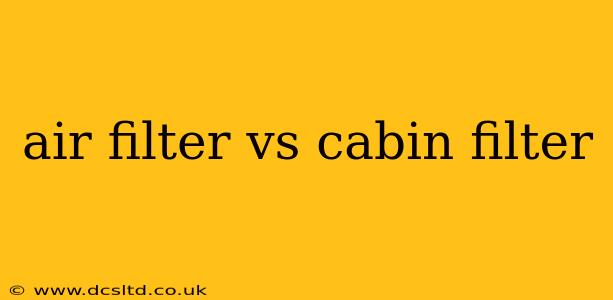Choosing the right filters for your car can seem confusing, especially when faced with terms like "air filter" and "cabin air filter." While both are crucial for maintaining your vehicle's health and your own well-being, they serve very different purposes and are located in different parts of the car. This comprehensive guide will clarify the distinctions and help you understand the importance of regular filter replacements.
What is an Air Filter?
The air filter, also known as the engine air filter, is responsible for protecting your car's engine from harmful contaminants in the outside air. It's located within the engine bay, typically near the air intake. This filter prevents dust, dirt, pollen, insects, and other debris from entering the engine, where it could cause damage and reduce performance. A clogged air filter restricts airflow to the engine, leading to decreased fuel efficiency, reduced power, and potentially even engine damage over time. Think of it as the engine's first line of defense against the outside world.
What is a Cabin Air Filter?
The cabin air filter, on the other hand, focuses on protecting you and your passengers. It's located inside the vehicle, usually within the HVAC (Heating, Ventilation, and Air Conditioning) system. Its primary function is to filter the air that enters the cabin through your car's ventilation system. This filter removes pollen, dust mites, mold spores, bacteria, and other airborne pollutants before they reach the interior. A clean cabin air filter ensures cleaner, healthier air inside your car, which is especially important for people with allergies or respiratory sensitivities.
What are the Key Differences Between Air Filters and Cabin Air Filters?
The most significant differences lie in their location, function, and impact:
| Feature | Air Filter | Cabin Air Filter |
|---|---|---|
| Location | Engine bay | Inside the vehicle's HVAC system |
| Primary Function | Protects the engine from outside contaminants | Protects occupants from airborne pollutants |
| Impact of Clogging | Reduced engine performance, fuel efficiency | Reduced air quality inside the vehicle, potential for allergies/respiratory issues |
| Replacement Frequency | Varies depending on driving conditions; generally every 12,000-15,000 miles | Varies depending on driving conditions; generally every 12,000-20,000 miles |
How Often Should I Replace My Air Filter and Cabin Air Filter?
How often should I replace my air filter? This depends heavily on your driving conditions. If you frequently drive on dusty roads or in areas with high pollen counts, you may need to replace your air filter more often. Consult your owner's manual for the recommended replacement interval, but generally, it's every 12,000-15,000 miles.
How often should I replace my cabin air filter? Similar to the air filter, the recommended replacement frequency for your cabin air filter depends on your driving environment. Heavier dust, pollen, and other pollutants will necessitate more frequent changes. A general guideline is every 12,000-20,000 miles, but again, your owner's manual should offer specific guidance.
Can I Replace My Air Filters Myself?
Replacing both air filters is generally a straightforward DIY task, but the difficulty can vary depending on the car model. Consult your owner's manual for detailed instructions and diagrams. If you are uncomfortable working on your vehicle, it's always best to take it to a qualified mechanic.
What are the Signs of a Clogged Air Filter or Cabin Air Filter?
Signs of a clogged air filter: Reduced engine performance, decreased fuel efficiency, difficulty starting the engine, unusual engine noises, and a noticeable decrease in acceleration.
Signs of a clogged cabin air filter: Musty odors from the vents, reduced airflow from the HVAC system, increased noise from the HVAC system, and worsening allergy or respiratory symptoms while driving.
By understanding the differences between air filters and cabin air filters, you can ensure your car is performing optimally and providing a healthy environment for you and your passengers. Remember to regularly check and replace these vital components to maintain both your vehicle's health and your well-being.
